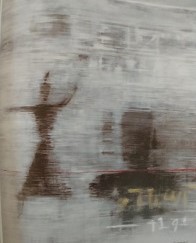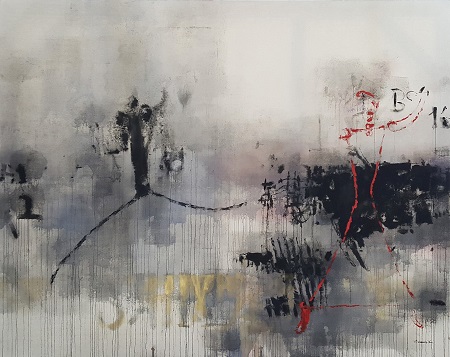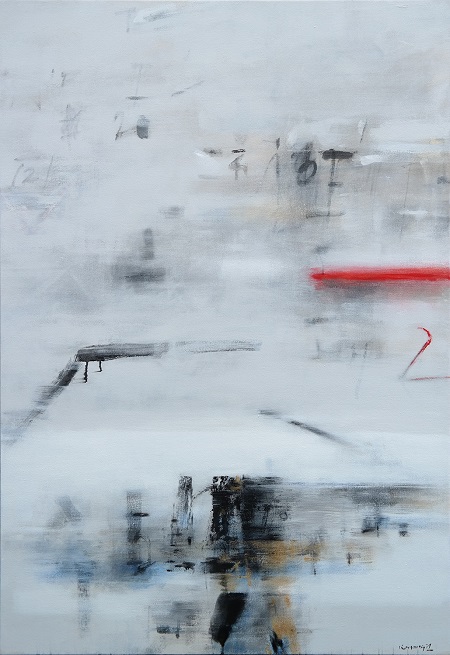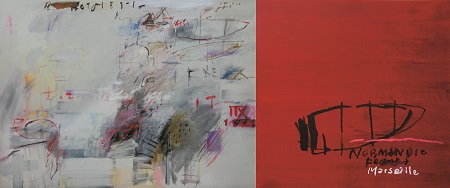Ko, Young Il Artist
Specially reviews in I A C O Gallery
Scope New York
2020
Ko's paintings are attributed to such reflections, namely, distant paving -" distance." His strict paintings are neither tempting nor willing to let us go. It does not seek to be nice, nor does it attempt to show off its odd workmanship. His paintings, which are extremely restrained and use accurate expressions, are directed toward reason through vision. Not many artists have such spiritual abilities.
고영일의 회화는 이러한 성찰, 즉 먼 포석 -『거리두기』에 기인한 것이다. 관조적이고 명상적이며 사려 깊어 엄격한 그의 회화는 우리를 유혹하지도 놓아주려 하지도 않는다. 그것은 근사함을 지향하지도, 희한한 솜씨를 보여주려 하지도 않는다. 극도로 절제된 채 적확(適確)한
표현을 구사하는 그의 회화는 시각(視覺)을 통해 사유(思惟)로 향한다. 이러한
영적능력(靈的能力)을 소유한 화가란 그리 많지 않을 것이다

Critic by Philippe Dagen, France
For more
than a century, Western painters have learned clarity and vividness. there,
looking at the far-East. They tried somewhat superficial genres, such as
woodblocks and calligraphy, which were all the more superficial as most of them
were unaware of the principles and substance of the field. They thought of
calligraphy as a kind of abstract expressionism combined with speed and gestures.
In other words, he thought that the artist's passion and behavior were free
symbols that could be imprinted. Therefore they understand calligraphy in an
easy manner, in spite of the risk of inadvertently discarding or distorting it,
and the risk of missing the fact that calligraphy has much more philosophy than
painting, not just being dictated by an impulse like a seismograph.
Here is a Korean artist named Ko Young-il.
He
travels from the high valleys of the Indus to the highlands of Rajasthan and
the Decan Plateau to the southern Indian city of Peninsula. What in the world
is this exile? Why are you leaving your hometown so far away from the circuit
of modern art? What's strange is that he knows Korean traditional calligraphy
and is also not aware of trends in American and European painting in recent
decades. Nevertheless, his conversation does not repeat or compromise. And he
doesn't smell of any academicism at all. He doesn't resemble anything we're
used to. It is an attempt to be free from precedent and identifiable models.
It's an attempt to understand and untangle something he sees and feels, to
shake and hold on to him.
In one place - no matter what part of India or what
part of the imagination it is - he neither tries to pull down a landscape nor
tries to describe something. Nor is he satisfied with some symbolic forms and
suggestive symbols. After all, he doesn't want an exact conception or a
complete abstraction. For him, this distinction is certainly not important at
all, and the constant debate over the abstracts and ideas of countless factions
in Europe and the United States is all the more meaningless. He's looking for a
pathway to what he calls "réalité" - no substitute for Dali - through
his own rhythm in his own way. Every single one of his works is this quest and
we can clearly read the attempt
Everything cooperates in his work. For example, he
excites the color with extremely intense red or yellow that can be seen on the
soil or in India, sometimes contrasting white with black. In recent works, a
thick black mass of textures, such as black and charcoal, is frequently
deployed in the center of the canvas and intrudes into space, darkening the
screen. This allows us to move our eyes around the screen like a live moon, in
order to prevent our vision from going further and to block the depth of the
screen. Is this just a conversational effect? Of course not. By blackening the
screen, Ko suggests the impossibility of perception, blindness, and the
concealment of Samra Mansang through night. In fact, it is an indirect
difficulty that conversation wants to overcome and avoid. Black is certainly a
strong denial and a threat here.
Most of the series of works on the title, 'Canadian Canaan,' seems to
cover these risks, their developments, and the artist's defense posture against
them. The artist must somehow protect the canvas from the black shadow that
falls upon it. As the splashes of paint, the hastily scribbled letters and
numbers are seen everywhere, the pots and glasses that look like rare objects,
the teas - all of which are black and blue - all of which are exactly unknown.
Isn't this all about rescuing and protecting them from being erased and
forgotten?
Is it symbolic contrast? It certainly is. It is
either the survival of the painting itself or the negation - the dark-like
monochrome. In the suspenseful canvas, the mood of the scene slowly heads down,
and the painting runs between two contradictory futures: the bright white
dazzle and the abyss of too deep a black. It looks balanced at first sight, but
this balance looks momentary and unstable. Such a balance as if one side is
lacking and one side will lean to the other. So the circle or the faint
contours of stones and trees are against this extinction.If there is a need for a comparison to justify this
logic, we can put Ko Young-il and Cy Twombly side by side. Their works share
the following points, despite their wide differences in production process and
appearance. Both men's works seem to have been drawn over the void. And the
feeling of weak, thin and fluid is a common factor in their work.
There is
a danger of being broken, but the painting still holds itself. Their paintings
refuse to be swallowed and dissolved. We know that the world of fables, books
and poems, countless names and works, Greece, and Roman mythology can one day
disappear. Already there is nothing left from them but broken ruins, dim
memories, uncertain and vague epitaphs. On too empty white paper, on top of
such a neutral gray monochrome, Tombly sprinkles blood-red, writes, and
scratches on incomplete figures, humble lines-and yet terribly gorgeous-in
spite of that.
Assuming that Ko's work is also similar to other
people's work, the author responds that his art acts are based on his clear
will to approach the essence more closely, distancing himself from the modern
era marked by chaos, exchanges, change and flight. He is willing to prepare for
today's haste and complacency, noise and quiet, distraction and calm. His
unflattering belief also links his affection for places like Radek and Janska,
where Buddhism has occurred and is preserved intact. He is also concerned about
Korea's unique culture, which is on the verge of serious degeneration and
oblivion. So he recently began to feature the form of an ancient pottery in his
paintings in a white canvas and a very faint gray shade. What does this
unexpected hint mean? Is it to remind us that one memory, one civilization, is
disappearing into a consistent, standardized international style?
To uncover their rather complex autobiographical
elements, is it an inappropriate comparison? American-born Tom Bly has already
been living a voluntary exile in Rome for more than a decade, and Korean Ko
Young-il has the same exile in Delhi. This departure and isolation clearly
indicate that both of them are refusing to compromise. They refused to join
this era because they have such a clear grasp of what the misfortune of this
era is. They felt they were strangers. In other words, they are looking at
things in a very general way.
Ko's
paintings are attributed to such reflections, namely, distant paving -"
distance." His strict paintings are neither tempting nor willing to let us
go. It does not seek to be nice, nor does it attempt to show off its odd
workmanship. His paintings, which are extremely restrained and use accurate
expressions, are directed toward reason through vision. Not many artists have
such spiritual abilities.

Ko Young Il theMyth,182x227,acrylic on canvas,1996 
painted Africa,97x162cm,acrylic on canvas,2009 
scenery,89x130cm,acrylic on canvas,2020

9-3 Ko Young Il,Myth, 120X260cm, Acrylic om canvas
|


